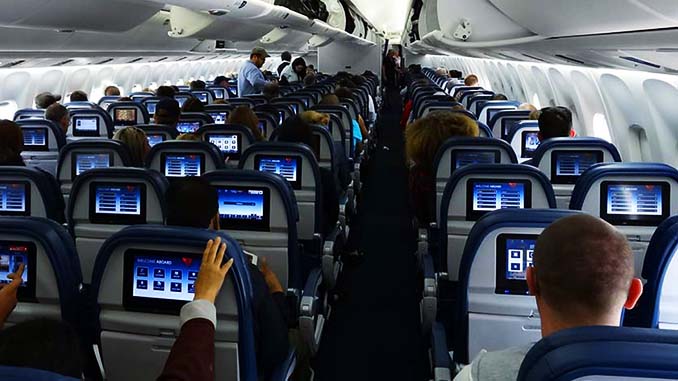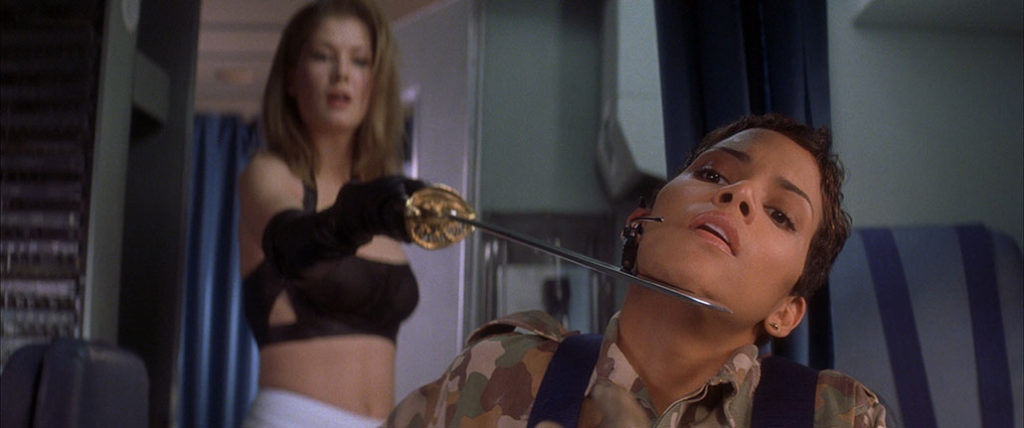
By Michael Kunkes
As regularly scheduled U.S. passenger jet service celebrates its 45th anniversary, major changes are taking place in the way inflight movies are being edited, repurposed and exhibited to passengers.
For all of that time, the predominant form of movie viewing has been what the airlines refer to as “main cabin,” projection of a movie onto overhead screens for all to see, not only paying customers, but also “passive viewers,” Who don’t purchase headsets and can still see the screen.
Today, digital and satellite technologies have helped create a new category, known as “personal viewer consumption,” that is built around the idea of individual screens, either in seat backs or concealed in armrests. Whether delivered by satellite, on-board, on-demand servers tape “jukebox” systems, web-based application or personal DVD players, personal viewer is already offering airline passengers something they never had before – a choice.
Most international carriers, notably Virgin Atlantic and Emirates, are switching entirely to personal viewer and showing unedited movies. Virgin Atlantic has never used overhead video and was the first airline to fit seat back TV in all classes, beginning in June of 1991.
“Preserving the content and artistry of the director is paramount to us, which is why we never edit a movie,” says Lysette Gauna, Virgin Atlantic’s head of media. “We treat our passengers as media-savvy viewers able to make their own choices. In fact, the first movie we ever showed was Airplane, which some would consider risqué, but we just thought it was very funny. Thankfully, so did our passengers.”
Partially due to shorter hops and the cost of putting a plane on the ground to wire it up with new hardware, US domestic carriers are, at least for the moment, sticking with overhead projection, with exceptions in business, first class, and on flights that continue overseas.
Is the main cabin going the way of the inflight meal? Will the new personal viewer formats leave editors, who have made a career in the airline niche, without a parachute?
What that means is that the process of cutting movies for airlines remains subject to certain time-honored rules. An aircraft in peril is undesirable, as are images of explosions, knives, box cutters, etc. Also questionable are scenes involving intense sexual content, lewd gestures, extreme violence and the like.
“We want to sell as many movies as we can, but it’s a balancing act where everything is on a case-by-case basis. Remember, these edits are for main cabin consumption.” Explained Gray Ainsworth, senior vice president of Technical Services in MGM’s Worldwide Distribution Group.
Today, airlines and production companies are going to greater lengths than ever to preserve the artistic content of a film while working within their own internal editorial and ADR guidelines.
“In today’s age, there is no norm anymore,” says Linda Palmer, senior vice president of Non-Theatrical at BuenaVista, a wholly owned subsidiary of the Walt Disney Company. “Buyers at airlines are becoming much more astute at looking at a film’s suitability. In the past, it was normal to hear: ‘We want that film, but you have to take that out.’ As studios have become more and more reluctant to make wholesale cuts, they’ve had to become more adaptable, and perhaps pass on a film they ordinarily would have bought.
Jacquie Young, an American Airlines spokesperson, says the airline bases its decisions on “the broadest possible appeal to our passengers, and not by how much content is cut out.” It’s most likely that if a movie has to be edited to an enormous extent in order to be considered for airline use, it would not be the one that an airline would want to purchase, she surmised.
For the most part, airline versions are cut by a dedicated staff person at the production company or studio. “The original editors are rarely available to do the airline or TV version,” says Ainsworth. “We always use union editors, who are very experienced at understanding our needs. In fact, sometimes they understand what we need to do better than the original editors, who don’t always provide the required coverage.”
“The enjoyment in this job comes from solving these problems and still seeing the movie work” – Vinnie Laino
At MGM, Vinnie Laino has been cutting airline and non-theatrical for over 12 years. For him, the challenges presented in negotiating the minefield of picture and ADR guidelines are highly creative. “We really try and lessen the effect of actually going in and cutting the film,” he said. “ We try and stay as true as we can to the director’s vision. However, if something is totally inappropriate, we can’t find a way to make it work easily, and it is not germane to the story, we will usually take it out. Most directors tend to be pretty understanding, as long as we take good care of the film and show them what we are doing.”
Bill Elias, a Guild member and a picture editor at Paramount Studios on airline versions and other ancillary markets since 1986, emphasizes the director’s importance to the process.
“Our job is to work within the airline’s parameters to protect the integrity of the film and serve the director. The airline versions are generally the point of initial censoring that will stay with the show, so we want to get director approvals on everything,” explains Elias.
According to Laino, the James Bond movies always provide a huge challenge, because even with their huge diet of sex and violence, they get sold, no matter what. The closing sequence of last year’s Die Another Day features two concurrent violent fights on a slowly disintegrating cargo plane. “We couldn’t just remove the last 20 minutes of the film, so we employed a lot of digital technology,” he says. “For the sword fight between Halle Berry and Rosamond Pike, we changed the swords into Kembo sticks, removed the knife from a fatal stabbing, covered up the holes in the plane and removed most of the flames and the actual crash into the mountain after Bond and Berry escape. The sequence is much shorter, but its integrity is preserved and you still get the feeling of the crash. The enjoyment in this job comes from solving these problems and still seeing the movie work.”
MGM has a complete set of TV/Airline ADR guidelines, as do most studios, that leave little room for interpretation. Among the over 250 objectionable words and phrases are no fewer than 56 replacements for “balls,” among which are “buds,” “puppies,” “slugs,” “lumps,” “brothers” and “nasties.” There are 40 variations and over 200 replacements for variations on the “f” word, enough to keep Joe Pesci permanently employed. “God” can only be used in a religious context or in response to an injury. Jesus is largely off-limits, “son of a bitch” can become “slug in a ditch;” orgasm becomes “finale” and one of the replacements for “motherf____r” is “melon farmer.”

“Word replacements are often dictated by the replacement phrase’s ability to fit the same lip-movements as the original dialogue,” says Ainsworth.
“On airlines, we don’t use mutes and blurs the way we do on TV versions” he continued. “If a director is really on the ball, he will realize that the movie is likely to be edited for other consumption and will shoot a second version of a scene, but that rarely happens.”
Is the main cabin going the way of the inflight meal? Will the new personal viewer formats leave editors, who have made a career in the airline niche, without a parachute? It is highly improbable.
“We haven’t noticed a decline in work says Elias. “Markets are growing and diversifying, and as with any other business, as the market changes, you adapt.”
Buena Vista’s Palmer adds, “While most airlines will begin to show unedited titles, there are regions of the world that have extremely restrictive codes for movies, such as Middle Eastern countries. So, even with personalized systems, we will continue to provide edited content.”
Laino agrees and points out, “We just did Windtalkers for personal viewer consumption, and still had to cut it down quite a bit, due to the extreme violence.”
Editing restrictions may lessen in the future, Laino added, but editors on airline versions will still have plenty to do.
“This will be especially true as we mine and repurpose our own huge library to meet the increased need for passenger choice. It’s a growing trend, and other studios, with their own libraries, are doing the same,”






